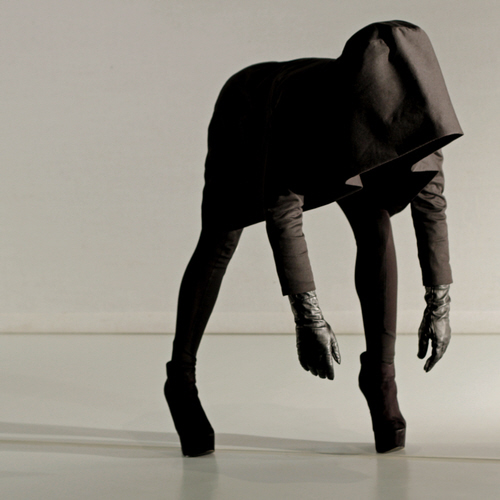Jon Gower visited the Studio in Chapter Arts Centre to witness the first production by Deborah Light, a triptych of dance performances in HIDE.
It’s a discombobulating beginning. A naked woman, pedestalled, stands shivering in front of us, just a few brief feet away from those in the front rows. She (Jo Fong) is seemingly terrified of us, the audience, as we take our seats. Her eyes are those of a startled rabbit in headlights. The very musculature of her body seems to join her teeth in their chattering. Finally, and with a palpable sense of relief she dons clothes, giving her the safety of disguise. She retreats to the safety, and anonymity of the stage’s back wall. In this show all available space in the Chapter’s Studio was used both as bolt-hole and background. This was a show where the performers shuttled between the declarative and the mute, between the extrovert and the hidden and things were always in motion, always mutable.

Studio, Chapter Arts Centre, Cardiff.
HIDE was designed by Neil Davies, who gave the cast an incredible flexibility of costume to challenge the spartan bare-black-box-with-a bunch-of-moveable lights of the stage design.
Working in tandem with the physical design was the sound world conjured up by artist Sion Orgon which was both metallic and broody, and occasionally abrasive, heightening the psychological reveals of the piece, as if Orgon was turning the aural equivalent to an arc lamp on the three dancers, and then ramping things up further with occasional accelerations of noise where the beats per minute reached discotheque velocity. The soundtrack also inter-spliced words from the piece’s characters – so nearly the same as the performers themselves, but not quite.
After the (intentionally) naked awkwardness of the beginning we were treated to a brief history of hairstyles, albeit Cardiganshire-style; the various periods which have seen performer Eddie Ladd lose her tresses, to settle on the trademark buzz cut she has enjoyed for the past two decades, even as she changed her name (she was originally Gwenith Owen) before Ms. Ladd gave us a flashback to the time when she learned to walk, or rather, strut like a man. As she gave us a demonstration I was put in mind of the builders working next door, all tense with testosterone.
The third performer, Rosalind Hâf Brooks, meanwhile, seemed to be perfecting the heavy metal art of high-velocity head banging as she kneeled on the floor and shook her head, as if she wanted to loosen it from her own neck, her long tresses hiding her face from view. There are Metallica fans in stadium gigs who don’t swing their skulls so much.
Kinetically, this was a work in constant movement, with the performers forming troupes and ensembles before separating back to their isolated and often troubled worlds. Fractured and dislocated, these were dancers who often didn’t want to be viewed, or be on view, and the idea of putting on a show seemingly kept them awake at nights.
It was a confident move on the part of the Cardiff-based dance artist and choreographer Deborah Light to add touches of humour to the mix, from the hapless sheep conjured up by the trio as they climbed on top of each others’ backs to the slapstick striptease sequence in which the trio of performers poured themselves in and out of each others’ clothes, like a classy Keystone Cop routine.
HIDE is Deborah Light’s first full-length work, following on from solo forays such as Angelica, between reality and Cortex, her commission for The Place Prize, the UK’s most prestigious prize for dance. In a video interview about the last of these works, Light’s description of it might well have served for HIDE:
‘There’s a lot of hair in the work, using that to explore transformations between different states of being, so…female, the animal, the bird, doll-like states, so many shifting between different worlds and different realities.’
And as we know there was a lot of hair in this new work. Similarly, the blurb for this new show suggested that HIDE ‘deals with notions of appearance and disappearance. It delves beneath our outer shell, revealing internal worlds, and exposing the multiplicity of human nature.’ It’s clearly, thus, an extension of earlier concerns, melding with and expanding the themes in ‘Cortex.’
So, if there was a presiding spirit at work here – other than the talented Ms Light, of course – it was perhaps Gwydion, the shape-shifting magician in the Mabinogion, who was also, according to Gwyn Alf Williams, the presiding spirit of Welsh history. Vacillating wildly between identity and disguise, display and concealment, this piece was a very motile pendulum, moving back and forth across the divide of gender, spanning the gap between the private, and sometimes deeply private individual, and the on-show vulnerability of the performer. It was chock full of ideas and frank in its complexity. And in the event, the performers, for all their better efforts simply couldn’t hide.











